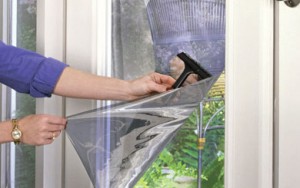 Homeowners have many options to improve the energy efficiency of their old windows.
Homeowners have many options to improve the energy efficiency of their old windows.
Q: Our house has its original single-pane windows and we always feel chilly near them. I got quotes for replacing them, but can’t afford it now. What can I do in the meantime to improve the efficiency of the old windows?
A: Especially on a cold winter night, old single-pane windows typically have huge heat loss and cold-air gain because of poor caulking and weather stripping (if there is any to begin with). You probably also feel hot near them during the summer!
The R-value—a higher-the-better number that shows the ability of insulation to resist the transfer of heat—of a single pane of glass is only R-1, as compared to an insulated wall at R-20.
However, there are many things you can do on a limited budget to improve the year-round efficiency of your windows. Before making any improvements though, check the condition of the caulking and weather stripping on the windows and make sure the framing has not deteriorated. If you find poor conditions, fix them before you attempt any improvements, or your hard work won’t be worth much.
Adding storm windows, either interior or exterior, can more than double the energy efficiency of existing windows. Custom-made, multi-track storm windows can cost almost as much as totally new windows, so make your own by using clear acrylic sheets. Another advantage is that using acrylic instead of glass blocks most of the sun’s fading ultraviolet rays.
Exterior storm windows can be made with 1×2-inch lumber, acrylic sheets, and foam weather stripping. If you size them to fit inside the wall opening and paint them to match the existing window frames, they will look like part of your windows. The compressible foam weather stripping should hold them in place in the opening, but push them in as far as possible to minimize the air gap.
To install interior storm windows, use a kit with magnetic seals. The seal’s magnetic section attaches to the acrylic sheet with an adhesive backing, and the steel strip attaches to the window frame. This allows easy removal during summer for ventilation, but if you use air conditioning most of the summer, just leave them up year-round.
Another option is to install insulating window shades or curtains. This will increase the overall insulation level of the window opening and block the radiant heat loss from your skin through the window. Something as simple as a pull-down pleated shade can also help quite a bit. Even closing Venetian blinds will block your skin’s exposure to the cold air.
Some of the most efficient window shades can add R-6 insulation to your windows. These are multilayer roll-up shades with a heat-reflecting air-proof inner film layer to greatly reduce radiant heat loss (or gain during summer). Closing these on a hot summer day helps cool your home, too. These shades are particularly effective because the side edges slide in channel tracks, which reduces the amount of air that circulates against the glass.
The newest energy-saving permanent window films are also effective for reducing winter-time heat loss. These films have just a very slight tint so they can’t be detected, and use the same type of microscopically thin low-emissivity metallic coating as expensive replacement windows. Simple vinyl static-cling film will also help. But before installing anything on double-pane windows, check the manufacturer’s warranty regarding film application.
Do-it-yourself energy-saving film installation kits are available at most home improvement stores. Depending on your climate, you may want to select a darker tint if summertime heat gain is your most significant concern. Because the sun rides higher in the sky during summer, install window awnings for shade and a lighter film on south-facing windows that will allow for some passive solar heating from the lower winter-time sun.
A final option is to install a tilt-in, double-pane, sash-only replacement kit. If your existing frames are in good condition, this will convert your old windows into very efficient ones. This option also provides the convenience of tilt-in sashes for the ease of cleaning both sides of the window glass from indoors.
James Dulley is a nationally recognized mechanical engineer writing about home energy issues for the National Rural Electric Cooperative Association. If you have a question for Jim, please email jdulley@countrylines.com, or mail to James Dulley, Michigan Country Lines, 2859 W. Jolly Rd., Okemos, MI 48864. Be sure to let us know which electric co-op you receive service from. Visit dulley.com for more home improvement and do-it-yourself tips.



